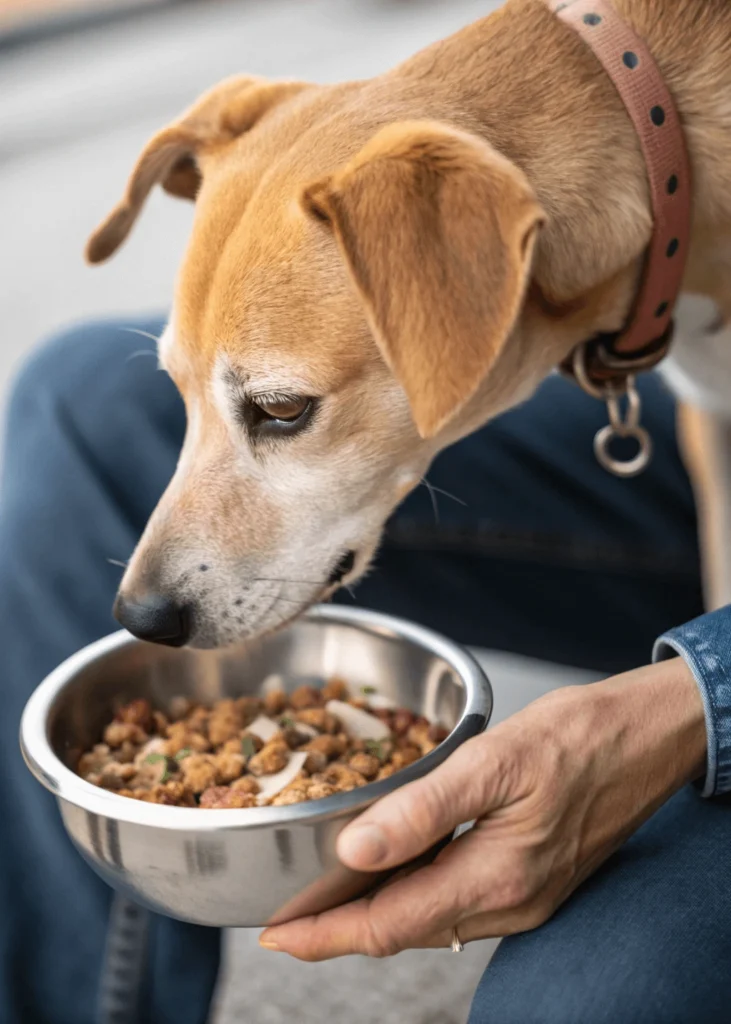When your dog isn’t feeling their best—maybe they’re vomiting, have diarrhea, or recovering from surgery—it’s natural to worry. That’s when a Bland Diet Scrambled Eggs for Dogs can come to the rescue. And yes, scrambled eggs can be a gentle, safe, and nutritious part of that healing plan.
This article explains why scrambled eggs are often recommended by vets as part of a bland diet for dogs scrambled eggs. We’ll walk you through how and when to serve them, provide a simple vet-approved recipe, and even include a sample 3-day feeding plan. Whether your dog has a sensitive stomach or you’re just looking to learn more about safe, natural meals, you’re in the right place.
Table of Contents
What Is a Bland Diet Scrambled Eggs for Dogs?
Why Vets Recommend Bland Diets for Dogs
A bland diet is exactly what it sounds like: a gentle, easy-to-digest meal plan designed to give your dog’s stomach a break. It typically includes plain proteins and easily digestible carbs. Veterinarians often recommend it when a dog is experiencing:
- Diarrhea or vomiting
- Post-surgical recovery
- Food poisoning or mild gastroenteritis
- Mild food sensitivities or allergies
- Transitioning between dog food brands
This temporary diet helps soothe the digestive tract, reduce inflammation, and give your dog a chance to heal without irritating their system further.
Common Symptoms That Call for a Bland Food Plan
If your dog shows signs like:
- Soft or watery stool
- Gurgling stomach sounds
- Lack of appetite
- Lethargy or vomiting
- Excessive drooling or licking lips (a sign of nausea)
…it’s time to call your vet and ask about trying a bland diet. In many cases, feeding your dog a few meals of mild, plain foods can reset their tummy and bring back their appetite.
Are Bland Diet Scrambled Eggs for Dogs?
Learn more about the benefits and safe prep tips in our complete guide to bland diets with eggs for dogs—a must-read for dog owners handling tummy trouble.
Why Scrambled Eggs Are Gentle on the Stomach
When it comes to bland foods, scrambled eggs often top the list—and for good reason. Eggs are packed with easily digestible protein and contain important nutrients like:
- Riboflavin (B2) for energy metabolism
- Selenium for immune support
- Biotin for skin and coat health
- Iron and phosphorus for healthy blood and bones
The simple composition of a plain egg—without seasoning, butter, or oil—makes it a stomach-friendly option. For dogs recovering from illness or experiencing digestive upset, scrambled eggs offer a mild yet nourishing protein source that’s easier to digest than heavier meats.
That’s why many veterinarians include scrambled eggs as part of a temporary bland diet, especially for dogs experiencing minor gastrointestinal issues.
Nutritional Benefits for Sick Dogs
Eggs aren’t just gentle—they’re also powerful little nutritional packages. Here’s a look at what your pup gets in every bite:
| Nutrient | Benefit for Dogs |
|---|---|
| High-quality protein | Helps rebuild tissue and maintain energy |
| Vitamin A | Supports vision and immune health |
| Folate | Aids in cell repair and digestion |
| Fatty acids | Supports skin, coat, and brain function |
That said, scrambled eggs should be served plain—no butter, no salt, and definitely no onions or garlic (which are toxic to dogs). Always use a non-stick pan or steam method without added oils to keep it truly bland.
When Can Dogs Eat Scrambled Eggs?
Best Times to Offer Eggs to Your Dog
Scrambled eggs aren’t just for Sunday brunch—they’re great for:
- Dogs with diarrhea or vomiting
- Picky eaters recovering from illness
- Dogs recovering from surgery or antibiotics
- As part of a bland rotation diet for dogs with sensitive stomachs
Because eggs are mild and generally well-tolerated, they’re an excellent first meal when your dog is coming off a fasting period or refusing regular kibble. Many pet parents see an improvement in appetite and stool quality after just one or two servings.
However, moderation is key.
Scrambled Egg Feeding Dos and Don’ts
Here are a few important tips before you serve those eggs:
| Do | Don’t |
|---|---|
| Use only plain eggs (no seasoning) | Don’t use milk, cream, or cheese |
| Let eggs cool before serving | Don’t serve directly from a hot pan |
| Feed small portions (1–2 eggs max per meal) | Don’t rely on eggs as a long-term food source |
| Introduce slowly with boiled rice or pumpkin | Don’t add salt, pepper, butter, or oil |
Some dogs might experience loose stools if they eat too many eggs, so watch your dog’s reaction carefully.
How to Make Dog-Safe Scrambled Eggs

Step-by-Step Dog-Friendly Scrambled Egg Recipe
Making scrambled eggs for your dog isn’t complicated—but there are a few key things to get right to ensure it’s safe, bland, and easy to digest.
Here’s a quick and vet-friendly recipe:
Dog-Safe Scrambled Eggs Recipe
| Ingredient | Amount |
|---|---|
| Fresh eggs | 1–2 large eggs |
| Water (optional) | 1 tablespoon |
Instructions:
- Crack the eggs into a bowl and beat until fully mixed.
- Optional: Add a tablespoon of water to keep them soft (no milk or cream).
- Heat a non-stick skillet on low to medium.
- Cook the eggs slowly, stirring occasionally, until fully done.
- Cool the eggs before serving—make sure they’re warm, not hot.
- Serve plain, either on their own or with plain boiled rice or pumpkin.
👉 Serving Size Tip:
- Small dogs (under 20 lbs): ½ scrambled egg
- Medium dogs (20–50 lbs): 1 scrambled egg
- Large dogs (50+ lbs): Up to 2 scrambled eggs
Looking for inspiration? Try our easy pumpkin and egg mash recipe—a perfect combo for sensitive tummies.
Ingredients to Avoid in Dog Scrambled Eggs
Many human-style scrambled eggs are made with butter, salt, or even cheese. While tasty to us, these can be harmful or irritating to your dog’s digestive system.
Avoid these common add-ins:
- Butter or oil – Adds unnecessary fat, hard on the stomach
- Salt and pepper – Can upset electrolyte balance
- Garlic or onion powder – Toxic to dogs, even in small amounts
- Cheese or milk – Most dogs are lactose intolerant
Keeping the eggs plain and clean is the best way to make sure your pup gets the nutrients—without the trouble.
Sample Bland Meal Plan Using Scrambled Eggs

A sick or recovering dog often loses appetite or struggles to keep food down. That’s where a structured bland diet meal plan—with scrambled eggs as a core protein—can offer both relief and nourishment.
Here’s a simple 3-day vet-inspired bland diet plan featuring scrambled eggs that helps ease digestion and gently supports recovery.
3-Day Bland Diet Plan for Dogs (Using Scrambled Eggs)
| Day | Meal | What to Serve |
|---|---|---|
| Day 1 | Breakfast | Scrambled eggs (½ to 2 eggs based on size) + plain white rice |
| Dinner | Boiled chicken (skinless, boneless) + mashed pumpkin | |
| Day 2 | Breakfast | Scrambled eggs + plain cooked oatmeal (unsweetened) |
| Dinner | Scrambled eggs + boiled mashed potatoes (no salt or butter) | |
| Day 3 | Breakfast | Scrambled eggs + boiled white rice |
| Dinner | Turkey (plain, ground, cooked) + pumpkin or sweet potato |
Make sure water is always available, and give meals in small portions throughout the day rather than all at once.
Portion Guidelines by Dog Weight
| Dog Weight | Scrambled Eggs | Carb Side (rice, oats, etc.) |
|---|---|---|
| Under 20 lbs | ½ scrambled egg | ¼ cup |
| 20–50 lbs | 1 scrambled egg | ½ cup |
| Over 50 lbs | 2 scrambled eggs | ¾–1 cup |
Pro Tip: Split meals into 2–3 servings per day to reduce strain on your dog’s digestive system and monitor symptoms after each meal.
What to Avoid When Using Eggs in a Bland Diet
While scrambled eggs are generally a safe, protein-rich option for dogs on a bland diet, there are a few important situations where eggs may not be the best choice—or may even worsen your dog’s condition.
Watch for Allergic Reactions to Eggs
Just like humans, some dogs can develop food sensitivities or allergies—and eggs are a common culprit.
Signs your dog might be sensitive to eggs:
- Excessive gas or bloating after eating
- Loose or mucousy stool
- Itchy skin, ears, or paws
- Vomiting soon after meals
- Ear infections or persistent licking
If your dog shows any of these signs, stop feeding eggs immediately and consult your veterinarian. They may recommend an elimination diet to identify the exact trigger.
When Not to Use Eggs in a Bland Diet
In some cases, scrambled eggs might not be the best choice—especially if:
- Your dog has pancreatitis (due to the fat content in yolks)
- They’ve been diagnosed with egg intolerance or allergy
- Your vet has restricted animal proteins for digestive reasons
- Your dog has severe diarrhea or worsening symptoms after eating eggs
Important: If symptoms worsen—more vomiting, diarrhea, or loss of appetite—pause the bland diet and contact your vet right away.
Tips to Keep Eggs Gentle on the Tummy
| Safe Practice | What to Avoid |
|---|---|
| Use only plain, fresh eggs | No seasonings, milk, or butter |
| Fully cook the eggs (no raw) | Never serve raw eggs to sick dogs |
| Pair with bland carbs | Don’t mix with kibble right away |
Being observant and responsive to how your dog reacts to food is part of loving them well. Your dog’s body will tell you what works—and what doesn’t.
Transitioning Back to Regular Meals
Once your dog’s stomach starts to settle and they’ve been eating their bland diet—including scrambled eggs—without any symptoms, it’s time to begin reintroducing their regular food.
But take it slow—rushing this process could undo the progress you’ve made.
Signs Your Dog Is Ready to Transition
Before moving away from bland meals, check for the following:
- No vomiting for 24–48 hours
- Normal or firm stools for at least two bowel movements
- Regular appetite without nausea or hesitation
- Normal energy levels returning gradually
If you’re unsure, it’s always best to ask your vet for confirmation.
How to Safely Reintroduce Regular Dog Food
Use the 25–50–75 Rule to help transition over 3–4 days:
| Day | Bland Food | Regular Dog Food |
|---|---|---|
| Day 1 | 75% | 25% |
| Day 2 | 50% | 50% |
| Day 3 | 25% | 75% |
| Day 4 | 0% | 100% |
Mix both types well in the same bowl so your dog can adjust gradually. Monitor for signs like gas, changes in stool, or vomiting.
Pro Tip: Stick with plain, high-quality kibble or home-cooked meals without added fats, spices, or new proteins during this time.
FAQs: Bland Diet Scrambled Eggs for Dogs
Are scrambled eggs considered bland food for dogs?
Yes. Scrambled eggs—when cooked plain without butter, milk, or seasoning—are considered a bland food. They’re easy to digest, rich in protein, and commonly recommended by vets for dogs with upset stomachs. Just be sure they’re fully cooked and served cool.
Can I give my dog scrambled eggs for an upset stomach?
Absolutely. Scrambled eggs can be a helpful part of a temporary bland diet if your dog is dealing with mild vomiting or diarrhea. Start with small amounts and monitor how your dog reacts before making it a regular recovery meal.
Can dogs eat scrambled eggs when sick?
Yes, in most cases. Dogs recovering from minor illnesses, gastrointestinal issues, or even post-surgery can benefit from scrambled eggs. They offer gentle nourishment without irritating the stomach. However, consult your vet if your dog is seriously ill or not improving.
Are scrambled eggs on a bland diet?
Yes. Along with boiled chicken, rice, and pumpkin, scrambled eggs are among the top vet-approved proteins for bland diets. They should be cooked plainly—no seasoning, no butter—and paired with simple carbs like rice or mashed potatoes.
What is the best bland diet for dogs?
A great bland diet includes plain protein + a simple carb. Here’s a typical formula:
Protein: Boiled chicken, scrambled eggs, turkey, or lean ground beef
Carbs: Plain white rice, oatmeal, or mashed potatoes
Optional fiber: Pumpkin puree or cooked carrots
Each dog is different, so it’s best to talk to your vet and adjust based on your dog’s size, age, and condition.
Can eggs irritate dogs’ stomachs?
They can, but it’s rare. Some dogs are sensitive or allergic to eggs, especially the yolk. Signs of intolerance include vomiting, diarrhea, or itchy skin after eating eggs. If you notice these symptoms, stop feeding eggs and consult your vet.
onclusion: Gentle Nutrition Starts with Simple Ingredients
A bland diet for dogs with scrambled eggs can be a powerful way to support your pup’s recovery from an upset stomach, illness, or surgery. With their gentle texture, digestibility, and nourishing protein, scrambled eggs are a trusted ingredient that many dog owners and veterinarians rely on during healing.
Just remember:
- Always cook eggs plain—no butter, oil, salt, or spices.
- Start slow, observe your dog’s response, and feed in small portions.
- Combine eggs with bland carbs like rice, potatoes, or pumpkin.
- Watch for signs of intolerance or allergies.
- Consult your vet before starting or stopping any dietary changes.
At Home Dog Recipes, we’re here to help you provide the safest, healthiest, and most loving meals for your furry friend. Because when your dog’s belly is happy, their tail will tell you everything you need to know.

Bland Diet Scrambled Eggs for Dogs
Ingredients
1–2 large fresh eggs (organic if possible)
1 tbsp water (optional, for softer texture)
Instructions
- Crack the eggs into a bowl and whisk thoroughly.Add 1 tbsp of water (optional) to soften the texture.Heat a non-stick skillet over low to medium heat.Pour in the eggs and cook slowly, stirring gently until fully cooked.Allow to cool completely before serving.Serve plain or mixed with boiled rice or plain pumpkin.
Notes
- Use this recipe short-term (2–5 days) to ease digestion during vomiting or diarrhea.
- Always consult your vet if symptoms persist.
- Do not use salt, pepper, oils, or dairy.
